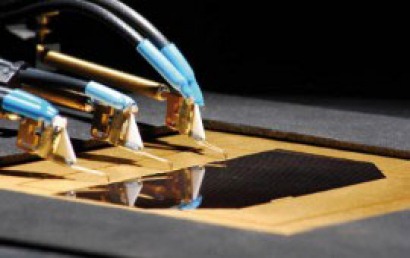
For over 15 years, the development and production of highly efficient multi-junction solar cells based on III-V semiconductors have connected the Fraunhofer Institute for Solar Energy Systems ISE in Freiburg and Azur Space Solar Power. This strategic partnership has now been confirmed for the next twenty years by the signing of an agreement of cooperation. In the coming years, Fraunhofer ISE will work exclusively with Azur Space, based in Heilbronn, northern Baden-Württemberg, on new generations of solar cells for applications in space.
Of all solar cells to date, the highest efficiencies for converting sunlight into electricity are achieved by multi-junction solar cells based on III-V semiconductors. The typical III-V materials used are, for example, gallium arsenide, aluminium gallium arsenide, gallium indium phosphide. In contrast to silicon, III-V semiconductors can be optimized to match specific wavelength ranges in the solar spectrum by carefully adjusting the atomic compositions.
To produce a multi-junction solar cell, several III-V-based solar cells, each of which absorbs a different part of the solar spectrum from the blue to infrared range, are monolithically stacked on top of each other. The cells are internally series connected by so-called tunnel diodes. The resulting stack of layers is quite complex and can consist of up to 40 single layers.
Due to the layering principle of the so-called “subcells” and the excellent crystalline quality of the III-V materials used, these multi-junction solar cells today achieve the highest efficiencies for the conversion of sunlight to electricity. In space, efficiencies of triple-junction solar cells are about 30%. Since 1995, III-V solar cells are used in space to power satellites.
The potential for this application has not yet been exhausted. In the future, III-V solar cells are expected to generate even more electricity per cell area, weigh less and be more robust so that they can better withstand the highly charged particles encountered in orbit.
Together with Azur Space Solar Power, the researchers in Freiburg are addressing these aims and developing innovative manufacturing processes for multi-junction solar cells of the next generation. The work is supported by the European Space Agency (ESA-ESTEC), the German Aerospace Center (DLR) and the German Federal Ministry of Education and Research (BMBF).
The research results are being successfully and promptly implemented in the products from Azur Space. “The manufacturing process developed at Fraunhofer ISE for multi-junction solar cells serves as the basis for the industry production carried out today by Azur Space Solar Power,” explains a pleased Dr. Andreas Bett, Deputy Director of Fraunhofer ISE and Division Director of “Materials – Solar Cells and Technology” at Fraunhofer ISE.
“And not least, it is the long-standing successful cooperation with Fraunhofer ISE that has made Azur Space a worldwide leader in manufacturing III-V solar cells,” comments Dr. Klaus-Dieter Rasch, CEO of Azur Space Solar Power in Heilbronn.
Azur Space has been involved in the field of space-based solar cells for more than 40 years, and during this time has successfully delivered solar cell technology for over 400 satellites. At present, Azur Space is focusing on bringing its latest solar cell technology from space back to the Earth for terrestrial applications.
With materials and structures originally developed to power satellites for telecommunications and Earth observation – for scientific, exploratory and navigation missions – Azur Space solar cells are now also demonstrating their excellent performance in terrestrial applications.
State-of-the-art, triple-junction GaAs cells for CPV applications achieve 40% efficiency under concentration, based on production experience (space and CPV) equivalent to 1,000 MW of solar power. Efficiencies of up to 50% are expected over the coming years with innovative multi-junction concepts.
[Photo: Multi-junction photovoltaic cell for space applications during measurement of current-voltage characteristics]
For additional information:

